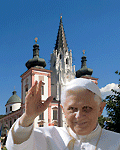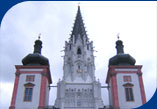ABSTRACT
The Archbishop's Palace is the residence of the Viennese bishops and archbishops and accommodates the apartments of the respective Cardinal-Archbishop and his assistants as well as the most important central offices of the diocesan administration and the General Secretariat of the Bishops' Conference. The Palace is located at the northern side of St. Stephen's Square where there used to be a vicarage which is first mentioned in records in 1267. In the course of the time, this vicarage was altered and extended - there even used to be a fortified tower at the side of the Rotenturmstraße which was destroyed during the building of the new Bishop's Palace. Bishop Anton Wolfradt (1631-39) initiated an extensive alteration of the building, which was finally finished under his successor bishop Friedrich Duke of Breuner (1639-69). In the years from 1632 to 1641, the Bishop's Palace was rebuilt as a monumental Mannerist Palace following the concept of the Florentine Builder Giovanni Coccapani and using the existing old structure. The building was arranged around two courtyards: the eastern one was done in the characteristic Viennese style of a courtyard open for traffic, and the western one is a synthesis of a castle courtyard and an atrium with a grotto-like fountain at the eastern wall. The Gallerietrakt, the so-called "Gallery-wing," is dedicated to the library and the archive of the Archdiocese of Vienna. The St. Andreas Chapel as well as a number of festival rooms and the consistorial hall are located in the Archbishop's Palace. In October 1938, a painting depicting the crucifixion was damaged by members of the Hitler youth attacking the Palace. This damaged picture is still hanging on a wall in the consistorial hall to act as a warning against facilitating violence as a means of dissolving a conflict.
_______________________________________________________________
The Archbishop's Palace, the residence of the Viennese bishops and archbishops, is located at the northern side of St. Stephen's Square where there used to be a vicarage which is first mentioned in records in 1267. After Vienna had been granted the status of a diocese by Duke Rudolph IV., the "Founder," in 1365, this vicarage became the residence of the Bishop of Vienna, and in the 15th century, during the pontificate of Pope Paul II. and under the rule of Emperor Frederick III., who established the Archbishopric of Vienna in 1469, the former vicarage was turned into the Archbishop's residence.
The old vicarage included the southern wing of today's Archbishop's Palace, which is located near St. Stephen's Square. In the course of the time, this vicarage was altered and extended - there even used to be a fortified tower at the side of the Rotenturmstraße which was destroyed during the building of the new Bishop's Palace. In the 16th century, necessary renovation works took place on behalf of Bishop Johann Fabri, Bishop Friedrich Nausea, and Bishop Johann Caspar Neuböck (1574-94), because, according to Bishop Johann Caspar Neuböck, the vicarage had been an "uncomfortable misera a ruinosa et tenebricosis angulis for a Bishop incommodissima habitatio." The renovation works, especially of those parts close to the Bischofsgasse, today's Rotenturmstraße - Wollzeile remained unfinished.
Bishop Anton Wolfradt (1631-39), who was given the title Prince by Emperor Ferdinand II. on August 2, 1631, initiated an extensive alteration of the building, which was finally finished under his successor bishop Friedrich Duke of Breuner (1639-69). In the years from 1632 to 1641, the Bishop's Palace was rebuilt as a monumental Mannerist Palace following the concept of the Florentine Builder Giovanni Coccapani and using the existing old structure. The building was arranged around two courtyards: the eastern one was done in the characteristic Viennese style of a courtyard open for traffic, and the western one is a synthesis of a castle courtyard and an atrium with a grotto-like fountain at the eastern wall. The two courtyards are separated by the Gallerietrakt, the so-called "Gallery-wing," which is dedicated to the library and the archive of the Archdiocese of Vienna. This wing was dedicated to the diocesan library in the 18th century and includes the bookstock of all Viennese bishops from the 16th to the 20th century. The library naturally contains a large number of theological works but also surprisingly many philosophical and historical books and books about natural science.
The festival rooms and the main staircase are located in the main wing, which faces the Rotenturmstraße. The design of the main staircase, built in 1752, was influenced by the French Rococo. The festive rooms, designed in 1716, is very appealing with its valuable and delicate stucco work. From 1932/33 to 1973, the Museum of the Diocese and St. Stephen's Cathedral, the so-called "Dom- und Diözesanmuseum," was located in these rooms. Under Cardinal König the purpose of these rooms was changed and they are now used for festivities and the awarding of honors. In these rooms, one can find remnants of the once valuable furnishing of the former Bishop's Palace, such as an Ebony veneered tabernacle, a work of highest quality done in Augsburg in 1680.
In October 1938, a painting depicting the crucifixion was damaged by members of the Hitler youth attacking the Palace. This damaged picture is still hanging on a wall in the consistorial hall to act as a warning against facilitating violence as a means of dissolving a conflict.
The St. Andreas Chapel at the southern side of today's Archbishop's Palace is first mentioned in records in 1267, and was designed like a typical Gothic chapel. In the 17th century, the chapel was renovated and got its today's form. In the course of the renovation, the wakes of St. Achatius and St. Andreas were combined and an inscription dating back to 1638 reminds of these old wakes. In the 19th century, the chapel was again renovated under Bishop Vinzenz E. Milde and Bishop Anton J. Gruscha, which is testified by a commemorative plaque inside the chapel.
In 1974, in the course of another renovation of the interior under Cardinal Franz König, the original coloring done in the 18th century was restored. The presbytery and the altar was changed according to the liturgical reform. A sufficient solution for the altar corresponding to the reformed liturgy had to be found and so the so-called "Annenaltar," the "St. Anne-Altar," was used as retable. The "St. Anne-Altar" is a sandstone epitaph and a chief work of Viennese sculpture built in the Perpendicular Gothic period. The altar dates back to 1512 and was rediscovered in the crypt of the Hofkirche St. Augustin.
In 1990, Cardinal Groer assigned the Chr.Allgäuer Organ Building Company from Lower Austria to install a so-called "Schwalbennest-Orgel," a "Swallows-Nest-Organ," in the St. Andreas Chapel.
Under Christoph Cardinal Schönborn, Prof. Oskar Höfinger manufactured a bronze statue of Sister Restituta Kafka, which was positioned in the chapel. During the Apostolic Journey of Pope John Paul II. to Austria in 1998, Sr. Restituta Kafka had been beatified as she had stood up for her faith and human dignity at the Regional Court of Vienna on March 30, 1943. She had been sentenced to death and beheaded under the National-Socialist Regime.
Today, the Archbishop's Palace is the residence of the Viennese bishops and archbishops and accommodates the apartments of the respective Cardinal-Archbishop and his assistants as well as the most important central offices of the diocesan administration and the General Secretariat of the Bishops' Conference.
Dr. Annemarie Fenzl
Diocesan Archivist of the Archdiocese of Vienna




 1
1 

